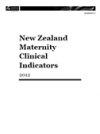The New Zealand Maternity Clinical Indicators are a tool for maternity service providers to assess the quality and national consistency in the delivery of maternity services in New Zealand.
The New Zealand Maternity Clinical Indicators are the result of collaboration between the Ministry of Health and maternity stakeholders representing consumer, midwifery, obstetric, general practice, paediatric, and anaesthetic perspectives. In 2011 an expert working group established a set of 12 maternity clinical indicators that could be measured using the available data collections at that time.
The expert working group has continued to review and revise the maternity clinical indicators since this time. This report presents 21 indicators, including six indicators new for 2013 that reflect care during pregnancy and the postnatal period, severe maternal morbidity and outcomes for babies at birth.
For this report, as with previous reports in this series, the ‘standard primipara’ definition is used to identify a group of women for whom interventions and outcomes should be similar. Of the 21 indicators covered in this report, eight apply to standard primiparae, six apply to all women giving birth, three apply to women who registered with a Lead Maternity Carer and four apply to all live born babies.
Since 2012, district health boards (DHBs) and maternity stakeholders have used the indicators in their local maternity quality and safety programmes to identify areas warranting further investigation at a local level. Using the data in this report DHBs and local maternity stakeholders can expand the scope of their investigations and view trends over a five year period.
As the previous reports demonstrated, maternity service delivery and outcomes vary between DHBs and between individual secondary and tertiary facilities. These findings merit further investigation of data quality and integrity as well as the local clinical practice management reasons for these variations.

